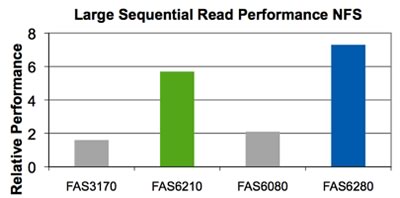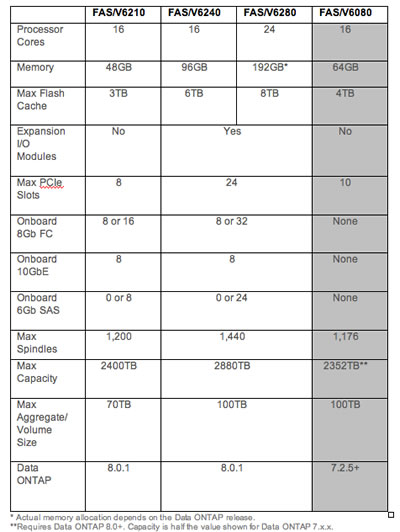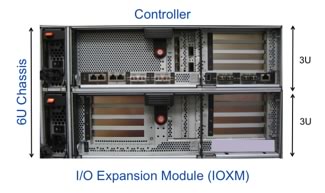Tech ONTAP Articles
- Home
- :
- Tech ONTAP Podcast and Blogs
- :
- Tech ONTAP Articles
- :
- Shared IT Infrastructure with the NetApp FAS6200 Series
Tech ONTAP Articles
- Subscribe to RSS Feed
- Mark as New
- Mark as Read
- Subscribe
- Printer Friendly Page
- Report Inappropriate Content
- Mark as New
- Subscribe
- Mute
- Subscribe to RSS Feed
- Permalink
- Report Inappropriate Content
 | |
Shared IT infrastructure, whether through large-scale virtualization or cloud, is the future of IT. You have to do everything possible to make sure that your storage is future ready and capable of meeting the demands of this new, more flexible and efficient IT model. The goal at NetApp has always been to deliver storage systems that bring together all the storage capabilities you need in a single package, while boosting efficiency and enhancing flexibility. The new FAS6200 series is the next step in that evolution. These new systems offer the performance and scale to make your storage future ready to meet the demands of even the largest shared IT infrastructure projects. In addition, each FAS6200 series system has a corresponding V6200 open storage controller model that lets you manage disk arrays from EMC, IBM, Hewlett-Packard, Hitachi Data Systems, and other major storage vendors as if they were NetApp® storage and take advantage of all the NetApp data management and storage efficiency features. These new platforms run Data ONTAP® 8.0.1 and deliver from two times to almost four times the performance of our previous high-end systems on recent internal benchmarks. Plus, they deliver great improvements in expandability and new features for reliability, availability, serviceability, and manageability to help you achieve even higher storage uptime. In addition, we’ve greatly simplified our software structure to make it even easier to configure software for a new system. Up to a 3.6X Performance BoostWhen we set out to refresh the FAS6000 series, we knew we needed to push the envelope in almost every dimension. Our goal was to allow you to consolidate more storage workloads than ever before onto a single storage system to support shared infrastructure or other needs, while still leaving lots of headroom for important storage tasks like data protection. In head-to-head comparisons using enough spindles, hosts, and host connections to eliminate the possibility of artificial bottlenecks, the FAS6280 handily outperformed the FAS6080 on every benchmark, including:
Figure 1) Relative sequential read performance of the new FAS6200 models compared to existing platforms These performance improvements are the result of innovations throughout the architecture including more and faster processing cores, more and faster memory, more NVRAM, support for greater quantities of Flash Cache, and an increase in the maximum number of spindles. The FAS6200 series uses the Iatest Intel® Westmere and Nehalem microarchitecture along with DDR3 memory to delivery industry-leading performance. As with the FAS6000 series, the FAS6200 uses a 64-bit architecture. However, the new Westmere and Nehalem processors are capable of providing much higher data throughput. The DDR3-1066MHz memory in the FAS6200 also offers much faster memory transfers versus the DDR-333MHz memory used in the FAS6000 series, so that that FAS6200 processor cores aren’t left waiting for the completion of memory transfers. We also added TCP/IP stateless offload to all onboard 10GbE network ports so that storage system cores don’t get bogged down with network processing. Overall internal bandwidth was increased to 90 gigabytes per second from 64 gigabytes per second using the new PCIe Gen 2 architecture and providing more I/O pathways to onboard connections and expansion slots. PCIe v2.0 (Gen 2) x8 architecture delivers bandwidth up to 4GB/sec to each slot versus 2.5GB/sec for the previous-generation systems. Table 1) Comparison of the three new FAS6200 series models with the FAS6080 (previous high end).
Superior ExpandabilityAlong with exceptional raw performance, we also set out to make the FAS6200 series more expandable than ever before, so you can scale up a system in multiple dimensions (connectivity, capacity, cache) without running into artificial limits. This was accomplished using three approaches:
The new FAS6200 chassis can contain two types of 3U components:
Figure 2) The 6U chassis of the FAS/V6280 and FAS/V6240 includes one controller and one I/O expansion module. The FAS6210 entry model is offered in a 6U chassis that contains one or two controllers for standalone or HA pair controller configurations in a small form factor. Both the FAS6240 and FAS6280 provide an I/O expansion module with each controller configured, so HA pair configurations consume 12U of rack space. An individual FAS/V6280 or FAS/V6240 controller provides half of the onboard ports indicated in Table 1. (Numbers in Table 1 are for HA pair configurations.) In addition, each controller has two vertical I/O slots and 4 PCIe slots. One vertical I/O slot is used by NVRAM and the second is reserved for either a NetApp FC or SAS I/O card. The I/O expansion module provides eight additional PCIe slots plus two vertical I/O slots that can be used for NetApp FC or SAS I/O cards. The result is that a single controller plus a single I/O expansion module offers 4 vertical I/O slots plus 12 PCIe slots. The maximum dual-controller configuration of the FAS6280, therefore, delivers up to 24 PCIe slots that can be used to support PCIe adapters such as:
The end result is much greater expandability and configuration flexibility than NetApp has ever offered before. Previously, situations existed in which you might have to trade off storage connectivity versus networking versus additional cache. With more built-in ports and more than two times the expansion slots, this is no longer the case. Support for the 10GbE unified target adapter also helps simplify the connectivity picture. With the NetApp Unified Connect infrastructure and UTA, you can run all storage protocols (FCoE, iSCSI, NFS, CIFS) over a single unified fabric without requiring separate adapters that can eat up available expansion slots. This capability is currently unique to NetApp storage. Reliability, Availability, Serviceability, and Manageability (RASM)In shared infrastructure environments, storage reliability, availability, and serviceability features become even more important. That’s why we’ve added to or beefed up the RASM features of the FAS6200 series. First, we’ve added a new feature to create a persistent write log. Battery-backed NVRAM is good for about 72 hours. After the battery discharges, NVRAM contents are lost. In certain disaster situations, there could be a long time interval before power can be restored. With the persistent write log feature, NVRAM contents are destaged to flash memory in the event of a dirty shutdown, protecting the write log indefinitely. On the next boot, the resulting NVLOG is simply replayed to restore the system to a consistent state regardless of how long the system was disconnected from power. We’ve also added a new service processor to the FAS6200 series that goes well beyond the capabilities of the remote LAN module (RLM) used in previous models. The service processor remains operational even when the rest of a storage system is down and can be reached through Ethernet or via the serial console. The service processor, also used on the new FAS3200, provides all of the features from the RLM, such as remote power cycle, call home notification of down system, and always-on access for troubleshooting. The service processor also adds new features that go beyond the capabilities of the RLM and include:
For out-of-band management of NetApp SAS disk shelves, NetApp has created its Alternate Control Path (ACP) technology. ACP enhances data availability by giving a storage controller the ability to reset a storage channel without having to communicate over that channel. If a channel is down or misbehaving, a quick reset can bring it back online without external intervention. ACP allows a storage system to recover from faults that might otherwise require it to reboot, and that’s a big advantage. ACP gives you a back door into your disk shelves. It is completely separate from the SAS data path and provides new options for nondisruptive recovery of shelf modules, including the ability to reset or power cycle an individual I/O module or an entire domain. We designed in the ability to power cycle an entire shelf as well. ACP technology enhances the ability of Data ONTAP to automatically reset a misbehaving component in order to return it to a fully operational mode without disruption. Our remote support diagnostics tool lets NetApp support staff access diagnostics data and AutoSupport™ information directly from your storage system via the service processor. Remote diagnostics can reduce the time needed to troubleshoot problems and lessen the burden on your storage administrators if a problem does arise. It also provides self-service management features. Because of the potential security concerns associated with remote access, we’ve paid special attention to security with:
According to an independent assessment by Symantec, remote support diagnostics conform to all security best practices. Simplified Software StructureNetApp has innovated over a period of many years to create new software features that add to the core capabilities of Data ONTAP and NetApp storage. In keeping with the NetApp philosophy, we’ve brought much of that functionality and value to you at no additional cost. However, a review of our software showed that we had 30+ options for you to choose from. We think you’ll agree that the situation was overdue for some simplification. NetApp began by grouping the most common options—including many options that were previously only available for a separate charge—into Data ONTAP Essentials. This is provided for the FAS6200 and FAS3200 series at no extra charge. Data ONTAP Essentials includes:
One storage protocol of your choice (iSCSI, FC, CIFS, NFS) is also included with Data ONTAP Essentials. We now also offer five additional software modules:
To make things easier still, you can also choose the Complete Bundle, which gives you all protocols and the five software modules shown above. ConclusionThe new FAS6200 and V6200 series are ideal for supporting business, cloud service providers, and virtualized and technical applications. These new systems are designed to deliver the performance, expandability, and RASM features necessary for large-scale shared IT infrastructure or any demanding IT environment. NetApp has also significantly simplified the process of installing and configuring software on FAS/V6200 and FAS/V3200 systems to make it even easier to get a new system up and online.  Got opinions about FAS6200 Series?Ask questions, exchange ideas, and share your thoughts online in NetApp Communities. Got opinions about FAS6200 Series?Ask questions, exchange ideas, and share your thoughts online in NetApp Communities. | Explore Future-Ready Storage Getting your storage infrastructure ready for the future is all about flexibility and efficiency. This special issue of Tech OnTap features articles on three technologies that will put you on the path to future-ready IT: Build Your Cloud with NetApp and Intel Technology NetApp and Intel have been working together to bring the benefits of unified networking using 10GbE and UTAs to the cloud. A recent "Cloud Builder’s Guide" describes tested configurations and performance results. |
Please Note:
All content posted on the NetApp Community is publicly searchable and viewable. Participation in the NetApp Community is voluntary.
In accordance with our Code of Conduct and Community Terms of Use, DO NOT post or attach the following:
- Software files (compressed or uncompressed)
- Files that require an End User License Agreement (EULA)
- Confidential information
- Personal data you do not want publicly available
- Another’s personally identifiable information (PII)
- Copyrighted materials without the permission of the copyright owner
Continued non-compliance may result in NetApp Community account restrictions or termination.
Interested in learning more about Unified Connect, check out the Play-by-Play
Thank you for the great article? I am wondering if there is a difference between SAS I/O and SAS Storage adapter. My understanding is that 6Gbps SAS board adapters that can be installed installed in the vertical slots are treated equally with those 6Gbps SAS adapters to be installed in the PCIe slots, is that correct?






